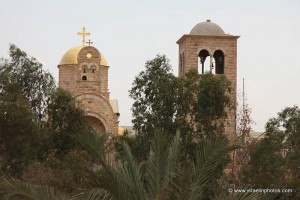
For years no one could visit the traditional site of the baptism of Jesus. And no one could visit any of the various Christian sect’s churches which over the years had sprung up around the site. The entire area was scattered with land mines in 1967 as an aftermath of the Six Day War. And until 2011 no one could visit the site called Qasr el Yahud. In 2011, a narrow path was cleared to the area on the Jordan River where Christians believe John the Baptizer baptized his cousin, Jesus. The site is also hallowed with the belief to be the site where Elisha rose to Heaven and the Israelites crossed the Jordan into the Promised Land. To get to the site pilgrims and visitors had to pass through a military checkpoint. As they walked the path, signs on either side gave the dire warning that the area was planted with land mines.
Enter the Halo Trust. The Trust is a British charity that works on projects to remove land mines. The Trust has secured the permission of both Israel and the Palestinian Authority, in addition to each of the Christian sects with an abandoned church in the area, to remove the mines. Coptic, Ethiopian, Greek, Romanian, Syrian Orthodox, Russian Orthodox and Roman Catholic church buildings on the 136 acre site will be able to be restored for their proper use. Nearby acreage owned by the Armenian Orthodox Church will also be de-mined.
Christian authorities have each spoken of the positive effects removing the land mines and opening up the area and its churches to pilgrims will have for the region.
At a time when many religious sites are being destroyed in the Middle East, the clearance of these churches by the Halo Trust offers a powerful symbol of hope. The Syrian Orthodox church supports Halo’s de-miners in their task, which will enable us to conduct mass and prayer in safety.
Mar Severios Malke Mourad, Archbishop of the Syrian Orthodox church in Jerusalem
The Franciscan church has long tradition of worship at Qaser al-Yahud, particularly at Epiphany. Whilst we continue to do so today, our access has been limited due to the deadly legacy of landmines. We look forward to the day when, thanks to Halo, we will be able to celebrate the sacrament of Christ’s baptism in safety.
The former Custos of the Holy Land, Father Pierbattista Pizzaballa
I am delighted to know that mines are being cleared on a Holy Site after so long. The clearance of these sites, and others in the Holy Land, are vital for the well-being of the local community. This site will allow more pilgrims to visit one of the holiest places in the region. The Jordan valley is not only the place where Jesus was baptized, it is a place where he stayed, preached and healed.
Archbishop Suheil Dawani, Bishop of Jerusalem
Episcopal Church in Jerusalem and The Middle East
At the heart of the Gospel of Jesus Christ is a message of reconciliation, so it is an inspiration to see Halo’s work helping communities to overcome these divisions. Everybody wants to see this land returned to use by the local Churches as a place of peaceful prayer and worship: Halo is reaching across the divide to make this vision a reality.
Justin Welby, Archbishop of Canterbury
The photo of Qasr el Yahud is from tourplanisrael.com. The photo of the abandoned church is from es.israelinphotos.com.
Information for the story was gathered from the Anglican Communion News Service.

